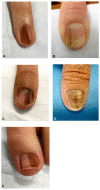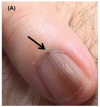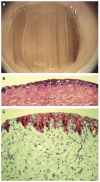Adult and Pediatric Nail Unit Melanoma: Epidemiology, Diagnosis, and Treatment
- PMID: 36980308
- PMCID: PMC10047828
- DOI: 10.3390/cells12060964
Adult and Pediatric Nail Unit Melanoma: Epidemiology, Diagnosis, and Treatment
Abstract
Nail unit melanoma (NUM) is an uncommon form of melanoma and is often diagnosed at later stages. Approximately two-thirds of NUMs are present clinically as longitudinal melanonychia, but longitudinal melanonychia has a broad differential diagnosis. Clinical examination and dermoscopy are valuable for identifying nail findings concerning malignancy, but a biopsy with histopathology is necessary to confirm a diagnosis of NUM. Surgical treatment options for NUM include en bloc excision, digit amputation, and Mohs micrographic surgery. Newer treatments for advanced NUM include targeted and immune systemic therapies. NUM in pediatric patients is extremely rare and diagnosis is challenging since both qualitative and quantitative parameters have only been studied in adults. There is currently no consensus on management in children; for less concerning melanonychia, some physicians recommend close follow-up. However, some dermatologists argue that the "wait and see" approach can cause delayed diagnosis. This article serves to enhance the familiarity of NUM by highlighting its etiology, clinical presentations, diagnosis, and treatment options in both adults and children.
Keywords: acral melanoma; longitudinal melanonychia; nail; nail unit melanoma; pediatric melanoma; subungual melanoma.
Conflict of interest statement
Conway has no conflicts of interest. Bellet has no conflicts of interest. Rubin has no conflicts of interest. Lipner has served as a consultant for Orth-Dermatologics, Hoth Therapeutics, and BelleTorus Corporation.
Figures













References
-
- Basurto-Lozada P., Molina-Aguilar C., Castaneda-Garcia C., Vázquez-Cruz M.E., Garcia-Salinas O.I., Álvarez-Cano A., Martínez-Said H., Roldán-Marín R., Adams D.J., Possik P.A., et al. Acral lentiginous melanoma: Basic facts, biological characteristics and research perspectives of an understudied disease. Pigment. Cell Melanoma Res. 2021;34:59–71. doi: 10.1111/pcmr.12885. - DOI - PMC - PubMed
Publication types
MeSH terms
LinkOut - more resources
Full Text Sources
Medical
Research Materials

